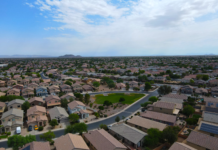The party conversation has flipped in the past two years. In 2005, all the talk was bragging how much money the housing appreciation had delivered. Now, it’s when is the home market going to turn around, and how does anyone sell a house in this environment?
What happened to the Central Arizona real estate market?
The short answer is that it shot way up and has floated back down some and has yet to reach whatever its new plateau might be. Here’s the brief version of that two-year history:
• During the housing price run-up of 2004-2005, the median price of a Valley home went up a nation-leading 47 percent. During the same time, Phoenix led the nation in job creation and population growth (and remains in the top three in those areas).
• That leap (some call it a catch-up) drew investors from California and elsewhere where such volatility is more common and prices were higher. They bought single family houses as speculative investments, assuming (correctly, during that era) that the increased value of the house would more than cover the cost of holding it. Some estimates put the percentage of speculative buyers as high as 25%.
• Meanwhile, builders couldn’t keep up with demand, went on a building binge and continually raised prices. There were lotteries and lines to buy.
• Also, the lowest mortgage rates in memory combined with the loosest lending practices also in memory allowed many people who previously could not qualify to get into houses. Many first-time, move-up and speculative buyers got homes with little or no down with adjustable rates and insufficient resources to handle the higher cost of borrowing that was right around the corner. Some did so right at the peak value of the market, meaning they owe more than their homes are worth, not even counting the cost of selling them. In “drive till you qualify” exburbs like Maricopa, legions who couldn’t afford housing in the metro core found exploding developments that they could get into. They came in droves. And builders kept building.
• After about a year and a half of this, prices leveled off, causing many investors to put their houses up for sale, creating a supply glut. Add to that the buyers who were in danger of losing their houses because they couldn’t afford the payments – and now the repossessed or soon-to-be-repossessed home that lending institutions have wound up owning.
So we have more houses for sale than ever before at higher prices and fewer buyers facing climbing mortgage rates, more scrutiny from lenders and fears that the bottom has yet to be hit, meaning they could pay more than a house might be worth months down the road. Could you have a more perfect storm?
You may look wistfully at those linear markets in the Rust Belt where housing appreciated slightly but consistently and continues to do so. However, if you bought your real estate during or before the ’04-’05 run-up, you still are probably in better shape than if the appreciation spike that preceded this slowdown didn’t occur. If you bought at the peak, hope you don’t have to go anywhere for a while.
In the face of all that, what’s someone who wants to – or worse, has to – sell a home to do?
The obvious answer is to make the deal more attractive. The two basic ways to do that are to give more or take less.
The simplest, albeit not the most comfortable, strategy is to lower the price. Those who bought before the run-up might be in a better position to do so than someone who laid down every nickel at the peak. One local Realtor advises sellers to price in the bottom half of the Competitive Market Analyhsis (CMA) report and to drop the price every three weeks until it sells. Also, price it below key numbers, meaning that you’ll get more traffic at $299,900 than at $302,500.
Offering incentives such as help with closing costs or rate buy-downs also might increase traffic of eligible or interested buyers. Sellers have offered home warranties, fix-up allowances, commission incentives to agents and the like. One seller even offered to leave the Mercedes in the garage. That might not net more cash in the seller’s pocket, but it keeps the official values of homes high. (Some argue that’s not a good thing because it extends the high price expectations of homeowners, who are not that far removed from that brief but brisk value run-up. That means it will take longer for lowered prices to reduce the saturated inventory of homes, which is what puts the buyers in control.)
Of course, if you have the big corner lot or a to-die-for view or the greatest back yard ever devised, then you have a “give” that the tract home down the block can’t offer. Maybe you can sell sooner or for more, although you still have to get interested buyers to look at your property.
Some owners who can afford to wait have opted to rent out their houses and wait out the market conditions. That is tougher to do in long-drive markets like Maricopa, particularly when others are in the same circumstance.
Housing appreciation has chugged along at 4 to 7 percent a year in normal times. The last time values in the Valley stalled was when the Resolution Trust Corp held a fire sale on properties inherited from the savings and loan collapse in the late 1980s. It took a few years, but once the inventory was absorbed, appreciation rates returned to historical levels. Real estate in Arizona has always risen, even if it took some waiting, like today.
So there you have it. The facts of life in today’s Arizona market means that sellers have to acknowledge that today’s real estate market as a glut of homes and a paucity of buyers, and they have to make realistic decisions about how to manage that.
The good news is that if you bought your house before the peak of the run-up you benefitted from that gain. The bad news is that, if you have to sell right now, you’re undoubtedly going to have to give at least some of it back.
















![Elena Trails releases home renderings An image of one of 56 elevation renderings submitted to Maricopa's planning department for the Elena Trails subdivison. The developer plans to construct 14 different floor plans, with four elevation styles per plan. [City of Maricopa]](https://www.inmaricopa.com/wp-content/uploads/2024/04/city-041724-elena-trails-rendering-100x70.jpg)

![Affordable apartments planned near ‘Restaurant Row’ A blue square highlights the area of the proposed affordable housing development and "Restaurant Row" sitting south of city hall and the Maricopa Police Department. Preliminary architectural drawings were not yet available. [City of Maricopa]](https://www.inmaricopa.com/wp-content/uploads/2024/04/041724-affordable-housing-project-restaurant-row-100x70.jpg)